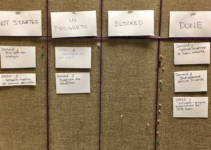If you want to get a better understanding of the project charter purpose, read on to understand what it’s for and how to create one….
Last night my daughter was sitting at her laptop. She was supposed to be doing homework, so I asked what she was working on (making sure it wasn’t actually Minecraft).
“I’m typing a story for school. It’s taking a really long time. Can you help me?”
I discovered that she’d typed two paragraphs, so I offered to type as she dictated. I took the laptop and read what she had so far – a story about a toddler who gets out of the house in the middle of the night and toddles away to the amusement park down the street. She tells me more of her story – and I resist the urge to edit since it’s her story and her homework.
She struggles with the storyline, asks for help, we get frustrated with one another, and we finally make it through in more time than it should have taken, with both of us irritated now. She gets to the end of her story, which involves kidnapping, mystery, and reunion.
“How many paragraphs?” she asks.
“Four,” I tell her.
She sighs. “It’s supposed to be five.”
Then she adds, “And it’s supposed to be a fantasy.”
Long pause, heavy sigh. I stifle a groan.
She shared none of this when we started working together. No indication of what the teacher had requested. No definition of the high-level requirements. Just, “A story for school,” which can have many interpretations.
This is what happens when you start your work with no clear definition of the deliverables or statement of work. This is why you need a Project Charter.
This is not the only goal of the Project Charter – but it helps to clarify and formalize things.
Let’s dig in a bit more for a better understanding of the Project Charter.
Scroll to the bottom to download the Project Charter templates (Word)
The Project Charter Purpose
To better understand the project charter purpose, let’s turn to the Project Management Body of Knowledge (PMBOK).
The PMBOK 5th Edition shares that the “approved project charter formally initiates the project.” It is encouraged that the project manager is identified before the charter is completed so that the project manager can be named in the project charter.
PMBOK goes on to say that the “project charter provides the project manager with the authority to plan and execute the project.”
The Project Charter provides these benefits:
- Gives the project team clear direction on what is to be delivered.
- Gives the project manager authority to use team resources and to execute the project.
- Demonstrates support from the project sponsor – (ideally, someone at an executive level – I will talk about executive support in a future post).
To create a good Charter, you need the following
- A clear understanding of the customer or business needs (why are you doing this project? What problem or need are you addressing?).
- High-level requirements/deliverables – nothing too detailed – just a high-level overview of what you’ll deliver.
- The desired results.
- Assumptions / constraints
- assumption examples: no new servers are needed / all software coding will be done in-house.
- constraint examples: no work can be scheduled during the week of Christmas / no travel will be approved due to budget cuts.
- Information about how the project aligns with any corporate strategic objectives – nice bonus information that is usually overlooked.
What goes into the Project Charter
- Project name.
- Problem or need being addressed – the problem the project will solve.
- Goals – what you will achieve by completing this project.
- Scope (both in and out of scope) – list what is included in the scope of the project and what is excluded. For example, if ongoing support is not included, be clear about that.
- High-level deliverables.
- Assumptions, constraints, and any key dependencies.
- High-level schedule targets/milestones if already identified.
- Budget – If you have a high-level budget estimate, you may include it.
- Project sponsor and key stakeholders.
- Sponsor sign-off – a critical component!
How to make it happen
- Consult team members for input and expertise.
- Work with team subject matter experts (SMEs) to identify assumptions and constraints.
- Work with business partners to ensure you clearly state the business need or problem you are addressing and the desired outcome.
- Work with team and business partner to identify the high-level requirements.
- Have sponsor for review for any questions or requested changes.
You’re almost done – formal approval
- Identify who will sign off – it should be someone who can grant authority to spend funds.
- Have Charter signed / approved.
- Store it somewhere it can be accessed by team members so that it becomes a formal part of the project documentation. Make sure others know that it has been approved and where they can find it.
Your office may already have a project charter template. If not, make your own with the components listed or click the link below to download samples. They can be used to create your own project charter template (Word version).
Conclusion
The Charter not only gives you the authority you need as a PM to execute the project but also outlines the justification for the project and gives guidance on creating your requirements and project schedule. With a Charter, you’ll arrive at the end with less frustration and reduced potential for rework, giving your team reason to celebrate.
Now that you know the project charter purpose and how to create one, use these samples/ templates I’ve provided to easily create one for your next project.
If you like this post, you might also find these helpful:
RASCI Chart Template and Instructions
How to Create Your IT Project Budget
Increase Project Success with a Stakeholder Analysis Template




No Responses